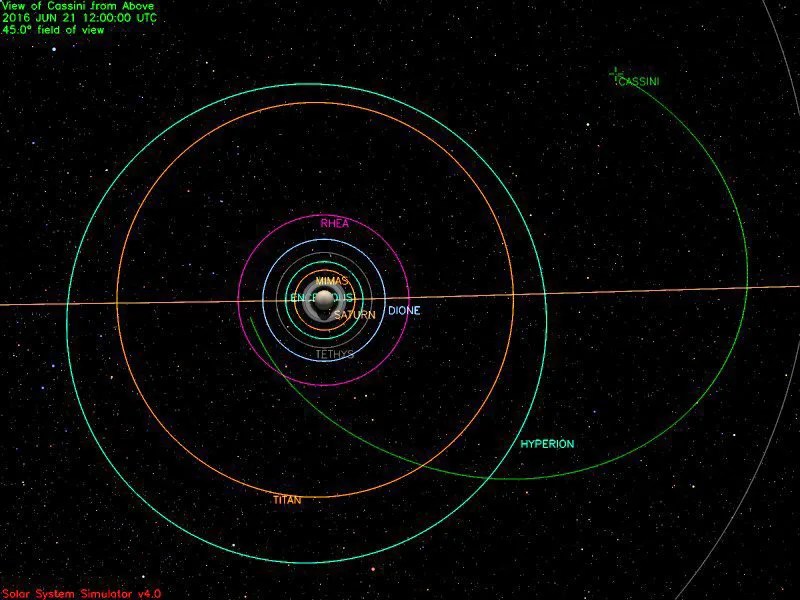4 min read
Cassini is orbiting Saturn with a period of 23.9 days in a plane inclined 43 degrees from the planet's equatorial plane. The most recent spacecraft tracking and telemetry data were obtained on June 22, using the 70-meter diameter Deep Space Network station in Australia. The spacecraft continues to be in an excellent state of health with all of its subsystems operating normally except for the instrument issues described at http://saturn.jpl.nasa.gov/anomalies .
Cassini lingered near the farthest point from Saturn in its orbit this week, while the onboard activities were controlled by the sequence of commands known as S94. Earthbound teams on two continents continued working on command sequences S95, which will begin executing on June 26, the S96 sequence, which goes active on Sept. 8, and S97 which starts in November.
Meanwhile, a series of science team meetings took place in Europe, leading up to Monday's start of the week-long Cassini Project Science Meeting (PSG) #69 at the European Space Research and Technology Centre (ESTEC), in Noordwijk, the Netherlands.
An image of Saturn featured this week makes it clear that winter is approaching in the planet's southern hemisphere, where the rings are casting deep shadows. The perplexing northern hexagon and polar hurricane are clearly visible: /resources/17380 .
Wednesday, June 15 (DOY 167)
Today's tasks, as Cassini moved slowly closer to apoapsis, did not require pointing the Optical Remote-Sensing (ORS) instruments' telescopes. Instead, the spacecraft stepped up its collection of data from the Magnetospheric and Plasma Science (MAPS) instruments as they reported on the in-situ conditions high in the morning sector of Saturn's magnetosphere.
Thursday, June 16 (DOY 168)
The Imaging Science Subsystem (ISS) controlled spacecraft pointing to observe Saturn's small irregular moon Tarqeq. Last week, this object was the subject of 89.5 hours of ISS's scrutiny. The observation that started today will last a little more than 37 hours. Cassini's Visible and Infrared Mapping Spectrometer (VIMS) and Ultraviolet Imaging Spectrograph (UVIS) rode along making their own observations. Though the spacecraft’s camera fields of view were aimed at Tarqeq, Cassini was also oriented so that the Cosmic Dust Analyzer (CDA) was orientated to optimize science for their retrograde dust campaign.
Friday, June 17 (DOY 169)
While the ORS instruments were studying Tarqeq, Cassini coasted through apoapsis, marking the start of its Saturn orbit #237. It had reached an altitude of 2.55 million kilometers from Saturn, having slowed to 8,676 kilometers per hour relative to the planet, about one-fourth its speed during the next periapsis passage.
Saturday, June 18 (DOY 170)
ISS, CIRS and VIMS performed a 90-minute observation in the Titan monitoring campaign while Saturn's planet-like moon was at a distance of 3.6 million km. When this was done, ISS turned and made a 60-minute observation as part of the satellite orbit campaign, examining the space near Saturn for small objects. CIRS and VIMS rode along. This pair of observations repeated on Monday.
Finally today, the Composite Infrared Spectrometer (CIRS) began leading a 23-hour long observation of Saturn’s atmosphere for in an effort to better understand its composition. ISS and VIMS rode along. The viewing geometry from dizzying heights near apoapsis in Cassini's highly inclined orbit is illustrated here.
Sunday, June 19 (DOY 171)
CIRS stared for 10 hours today at the sunlit side of Saturn's broad A ring, obtaining thermal infrared spectra for use in studying ring particle composition. UVIS and VIMS rode along.
Monday, June 20 (DOY 172)
CIRS led UVIS and VIMS again in another 10-hour ring observation, this time collecting spectra from Saturn's stranded C ring, again for studying the composition of its particles.
Back on the home planet, the Cassini PSG opened today at ESTEC.
Tuesday, June 21 (DOY 173)
VIMS observed the red star 2 Centaurus for 22 hours. The first two hours served for calibration, and then for the next 20 hours VIMS and CIRS watched as the star gradually passed behind Saturn's rings. This stellar ring occultation served to probe the optical-depth structure of the rings.
On three occasions during this week, while Cassini's optical instruments were pointing at or near Saturn, ISS carried out two-minute Saturn storm-watch observations.
The Deep Space Network communicated with and tracked Cassini on three days this week, using stations in Australia. A total of 9,329 individual commands were uplinked, and about 760 megabytes of telemetry data were downlinked and captured at rates as high as 142,201 bits per second.
This illustration shows Cassini's path up to mid-day June 21, 2016.








